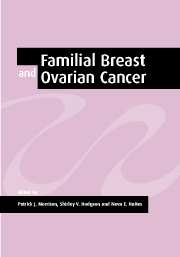Book contents
- Frontmatter
- Contents
- List of contributors
- Foreword by Helena Kennedy
- Preface
- Acknowledgements
- Part 1 Molecular biology and natural history
- 1 Introduction
- 2 Overview of the clinical genetics of breast cancer
- 3 Cowden syndrome and related disorders
- 4 Overview of the clinical genetics of ovarian cancer
- 5 Ovarian and breast cancer as part of hereditary non-polyposis colorectal cancer (HNPCC) and other hereditary colorectal cancer syndromes
- 6 The natural history of hereditary breast cancer
- 7 Pathology of the breast and ovary in mutation carriers
- 8 Risk estimation for familial breast and ovarian cancer
- Part 2 Screening
- Part 3 Management
- Index
7 - Pathology of the breast and ovary in mutation carriers
Published online by Cambridge University Press: 24 August 2009
- Frontmatter
- Contents
- List of contributors
- Foreword by Helena Kennedy
- Preface
- Acknowledgements
- Part 1 Molecular biology and natural history
- 1 Introduction
- 2 Overview of the clinical genetics of breast cancer
- 3 Cowden syndrome and related disorders
- 4 Overview of the clinical genetics of ovarian cancer
- 5 Ovarian and breast cancer as part of hereditary non-polyposis colorectal cancer (HNPCC) and other hereditary colorectal cancer syndromes
- 6 The natural history of hereditary breast cancer
- 7 Pathology of the breast and ovary in mutation carriers
- 8 Risk estimation for familial breast and ovarian cancer
- Part 2 Screening
- Part 3 Management
- Index
Summary
Introduction
Breast cancer is a leading cause of cancer death in women. It is estimated that 1 in 12 women will develop breast cancer in their lifetime. Risk factors for breast cancer include: age, early menarche, late menopause, obesity (particularly in postmenopausal women), oestrogen replacement therapy and a positive family history.
The majority of breast cancer (95%) is sporadic in nature and only a small proportion, in particular those diagnosed in young women, is due to a hereditary predisposition. This predisposition is transmitted as a highly penetrant autosomal dominant trait. Over the last 5–10 years, there has been considerable progress in the identification and localization of the genes responsible for hereditary breast cancer. In particular, two have attracted the most attention – BRCA1 and BRCA2 (Miki et al., 1994; Wooster et al., 1995).
The BRCA1 gene is located on chromosome 17q21 and encodes for a protein of 1863 amino acids (Miki et al., 1994). The protein includes a zinc finger motif, which suggests a possible role in transcription. Evidence is also accumulating for a role in DNA repair. Mutations in the BRCA1 gene are associated with a risk of breast cancer of approximately 80% and a risk of ovarian cancer of approximately 40% by the age of 70 years (Ford et al., 1994; Easton et al., 1995). The BRCA1 gene accounts for approximately 45% of all hereditary breast-cancer-prone families. Patients with mutations in the BRCA1 gene also have a slightly increased risk of colon and prostate cancer (Ford et al., 1994).
- Type
- Chapter
- Information
- Familial Breast and Ovarian CancerGenetics, Screening and Management, pp. 108 - 124Publisher: Cambridge University PressPrint publication year: 2002



